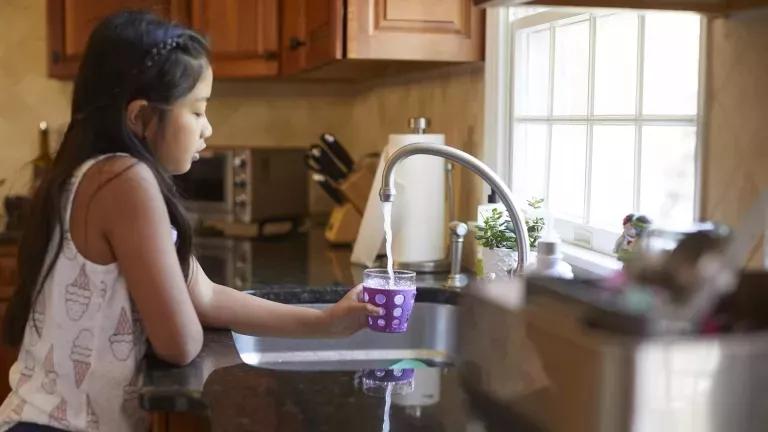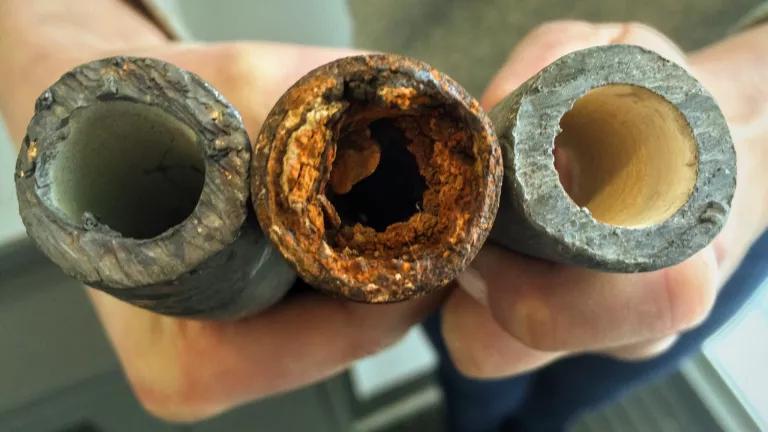
Brian Maranan Pineda for NRDC
The Biden Administration recently proposed new safe drinking water rules, which aim to replace all of the toxic lead pipes that deliver water to up to 22 million people nationwide. The proposal takes a major step forward from the failed efforts of the past 50 years, which left the vast majority of these pipes in use—even after Congress banned the installation of new lead pipes in the 1980s.
It is well-established by medical experts that there is no safe level of lead exposure. The millions of lead pipes that are still in use can leach lead into the water, harming children and adults alike. Replacing these pipes nationwide will have enormous health and economic benefits, far outweighing the costs. The proposed rule aims to achieve that goal within ten years.
Yet, some would prefer that the U.S. Environmental Protection Agency (EPA) allow more generations of children to grow up drinking from a lead straw, with utilities replacing lead pipes over many decades if at all. Why?
Many water utilities argue that the costs would inevitably cause water rate increases that make water utility bills unaffordable. They are wrong, for several reasons discussed below.
In short, water systems must embrace strategies that both pay for lead pipe replacement and protect affordable access to safe drinking water for everyone.
As we said in a September 2023 letter to EPA, joined by 79 organizations: “EPA must not accept the false premise that drinking water can be either safe from toxic lead or affordable, but that it cannot be both. It can and must be both.”
How can we achieve these goals?
The answer involves:
- spreading the utility’s costs across all customers, not just those whose lead pipes (known as “lead service lines”) are replaced;
- maximizing efficiencies in utilities’ pipe replacement programs, so cost isn't grounds for delay;
- maximizing use of funding from sources other than customers, such as federal and state funds; and
- abandoning regressive rate structures, in favor of more equitable approaches that don’t ask low-income households to pay more than they can afford for essential water services.
Cover the cost of full lead pipe replacement, spread across all customers.
Water utilities must not place the burden on individual homeowners to pay thousands of dollars to replace the portion of the lead pipe running under their property, from the curb to the house. These pipes are an essential part of the infrastructure that delivers water from treatment plants to homes. Typically, they were also either installed by the water utility or using materials (such as lead) that were required by the water utility or municipality.
Water utilities routinely pay to repair or replace the portion of a water main that serves a particular block, rather than having the residents of that block pay individually. This happens without any controversy. The same is true for all sorts of water infrastructure projects, regardless of whether a pipe or pump serves one neighborhood or an entire city. Lead pipe replacement must be treated the same way.
Getting the lead out must be funded collectively by all users of the water system and—particularly in disadvantaged communities—subsidized by state and federal funds available to the utility.
But EPA’s proposed rule comes up short on this critical point. It highlights federal funds that can help utilities pay for full lead pipe replacements. But it allows the utility to choose whether to pay to replace the portion of the pipe that runs under private property. If the utility chooses not to pay, and the homeowner is unable to pay or a landlord won’t agree to pay, the utility just leaves the lead pipe in place. Even worse, the utility may perform a “partial” replacement in these cases, removing only the portion of the pipe from the water main to the curb; this poses a risk of more lead leaching into the water than if the full pipe were left in the ground.
This must be fixed when EPA issues a final rule next year. Experience shows that when water systems shirk responsibility for the lead pipes running all the way to the house, low-income residents and people of color are harmed the most. That’s simply unjust. Safe water is a right, not a privilege that depends on wealth, race, or zip code.
You can call on EPA to require water utilities to replace all lead pipes within ten years and cover the full cost, so no one is left behind if they can’t afford to pay. Click here to send a message.
Don’t use “affordability” as excuse for delay; put the true costs in perspective and work smart to bring them down further.
EPA must also ensure that water utilities take no more than a decade to remove their lead pipes. We don’t want another generation of our kids to be harmed by lead pipes that are contaminating their tap water, or to expose adults with cardiovascular disease to additional long-term risks of a heart attack or even death from prolonged exposure to lead in drinking water.
EPA’s proposal generally sets a 10-year deadline for lead pipe replacement. But it has a loophole allowing up to 40 or 50 years for some cities, including Chicago, which has more lead pipes than any other city in the nation. This, too, must be fixed in a final rule. “Affordability” is not a barrier.
Our September 2023 letter urged EPA to resist calls to water down its lead rules based on concerns over affordability. We noted that opponents of a strong rule overstate the likely compliance costs and the significance of those costs relative to the utilities’ overall budgetary needs. Smart implementation strategies can further reduce costs. Moreover, we highlighted many steps water utilities can take to fund the true costs of lead pipe replacement while protecting low-income households from unaffordable rate increases.
Reduce the share of true costs passed on to water customers; protect low-income households especially.
After reducing costs, the next step is to fund a lead pipe replacement program without relying exclusively on revenue from customers. This includes maximizing the use of available federal and state infrastructure funding, which reduces the burden on all of a utility’s customers.
Finally, while those federal and state funds are a tremendous resource, we know they still won’t cover all of the costs. Water utilities must also use approaches that generate more revenue from local ratepayers, without imposing unaffordable burdens on low-income residents. Utilities typically overlook this strategy, entirely.
Local water rates are typically regressive. That is, people with the lowest incomes pay the greatest share of their income to meet their essential water needs, and rate increases hit them the hardest. It doesn’t have to be that way.
There are many options available to more equitably distribute the cost of maintaining and improving community water systems—infrastructure that provides vital public health services to the entire community. These include:
- capping bills for low-income residents at a percentage of income;
- adopting “lifeline” rates, applicable to all customers, with a low charge for an initial amount of usage sufficient to meet each household’s essential needs;
- offering other forms of bill discounts specifically to low-income customers;
- helping low-income customers repair plumbing leaks and replace old, water-guzzling toilets, which can both reduce utilities’ water supply costs and provide ongoing bill reductions for low-income households.
NRDC recently published an extensive Water Affordability Advocacy Toolkit, along with the National Consumer Law Center (NCLC), which lays out a roadmap to adopting these approaches and other complementary solutions. As highlighted in the toolkit, there are water utilities around the country using each of these approaches, to varying degrees, but most utilities still are not. Now is the time.
With all of these opportunities for water utilities to equitably fund lead pipe replacement, EPA must adopt a final rule that (1) requires utilities to cover the cost of replacing the entire lead pipe and (2) closes the loophole allowing extended timeline for replacement, so that everyone has safer water in 10 years or less. You can send EPA that message in just a few clicks here; the agency is taking comments on its proposal until February 5, 2024.




